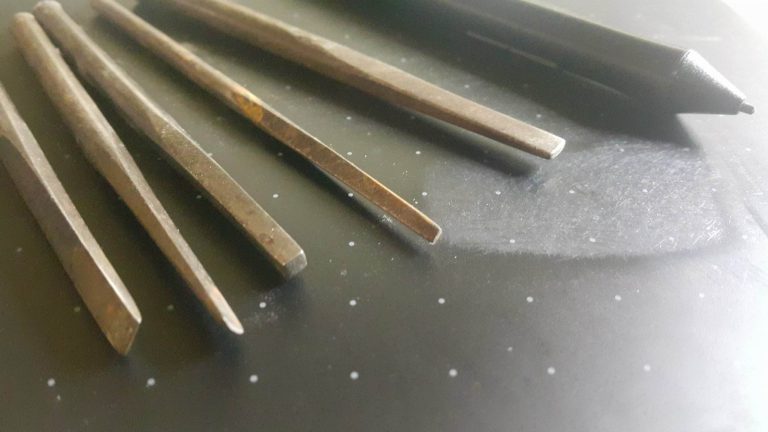From chisels to graphic tablet

This photo of a graphic tablet with five pieces of iron might look a bit curious for a new generation of jewelers in their 30s or younger. For me, however, it represents a symbol of the past and the present merging together.
For those of you who have studied the art of chiseling by hand it will definitely be less strange.
This photo reminded me of the 80s, when together with other fellow apprentices I studied goldsmithing; there were very few of us, since that’s how the training usually goes.

Learning from the masters
The first day we were sent by our teachers to buy a weirdly looking hammer, some files and several meters of silver steel that would then be cut manually.
Confusion was the expression clearly read in our faces.
Then we were asked to cut about 50 pieces of about 10 centimeters, which in weeks, after being based in Lima, grinding and polishing, would be transformed into our chisels.
Upon these steps being fully realized, techniques repeated, and pieces retouched with patience by those teachers available at that moment, until they were finally accepted. We were taught the final process; I remember my teacher’s words on the day we would have our first tools:
“Heat the tips until they are yellowish white and throw them into the oil!” That order was announced to us as if we were sailors following the directions of the captain of the ship.
Squares, rounds, straight lines, curved, polished or with texture and a variety of shapes and sizes that would allow us to start hitting and trying to shape some pieces of bronze plate.

The process began with a delicate cover of white water paint, which when dry would be the one that allowed us to make drawings with graphite on the bronze of the design to be chiseled, a guide, then these pencil lines were marked with chisels and, washing the plate , our pattern for the design was raised.
Then the plate was beaten from behind with huge steel balls giving it volume that would then be filled with sealing wax to be deposited on wood, to begin the work.
Blow by blow, the bronze (which was what we practiced our first steps of chiseling on), was deformed while the wax remained warm, each shape had to be gently beaten, rounded and marked by our chisels.
No one escaped from being painfully burnt with the wax, and all of us still remember how it hurts!!!
Perhaps, this article contains more personal than technical elements, I find it interesting though, especially considering that the articles on jewelry that I usually find today, in addition to being impersonal and hurried, are often mere subtly reformed copies of fillings for web.
I believe that an experience without being shared is just like the one which had never been lived.
Like certain languages that today we call dead languages some techniques of goldsmithing are destined to disappear or rather to evolve.
As in the current process of 3D sculpture, chiseling started with more general parts, defining volumes, forms overall; as it was advancing in the design they were seeking details to be finer and finer to achieve the final result.
Drawing parallels with creating my own tools by hand, I consider it important for today’s digital sculptors, in addition to their constant logical learning, to foster the intention to innovate even to design their own digital tools from scratch.
Another element that I consider a great addition to the evolution of any professional is a humble and meticulous observation of the most capable people, of the most outstanding works and artists, but their imitation should only be reserved to the field of evolution and learning personal, and not for that reason never lose your own artistic impulses, look for new ways, try to innovate, and try to generate interesting and original works.
Try to approach everything as if was ART…
Personally, I consider that such attitude is what separates true artists from the rest of the world, irrespective of being recognized or not.
I dedicate this article to my first three great masters of chiseling: Aldo Sotilli, Marcelo Arredondo, and Mauricio Nizzero, for the patience in trying to teach us those techniques and passing over the love to art.
Wherever you are .



